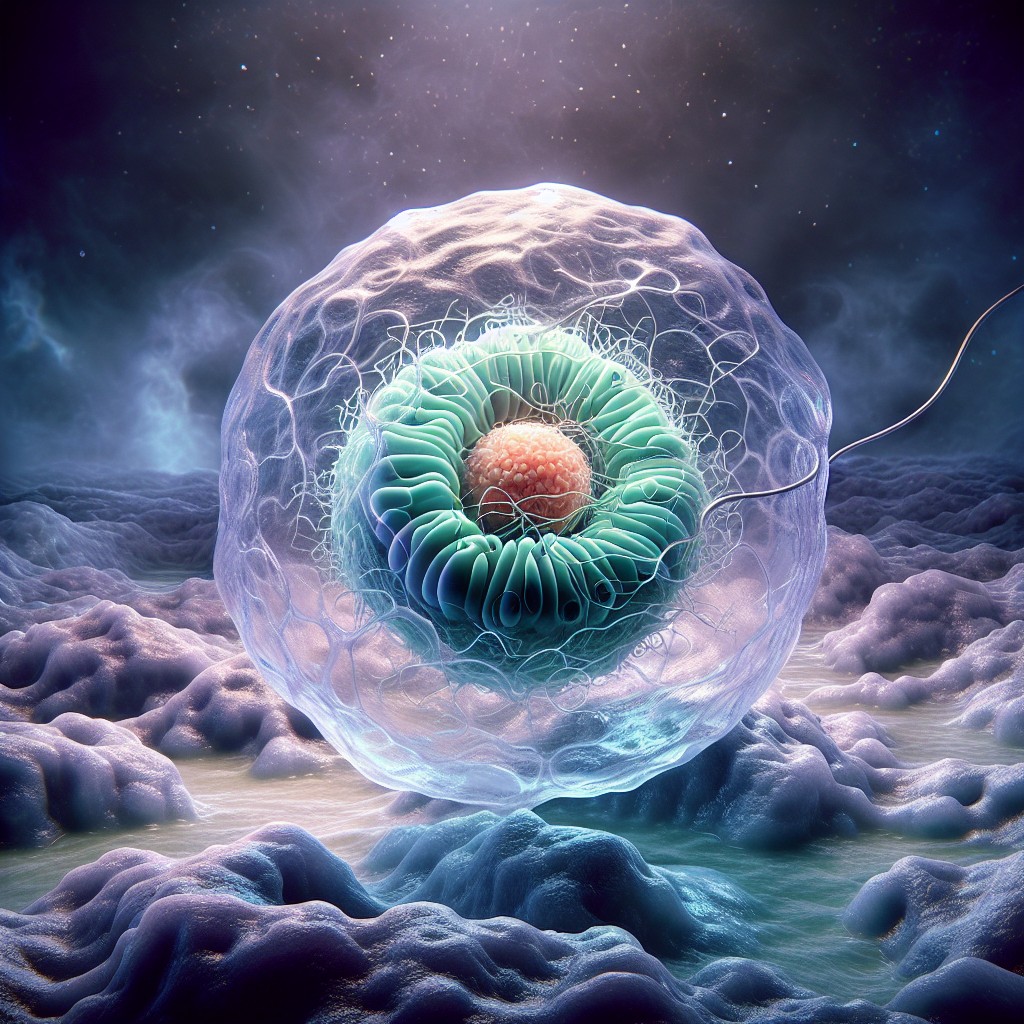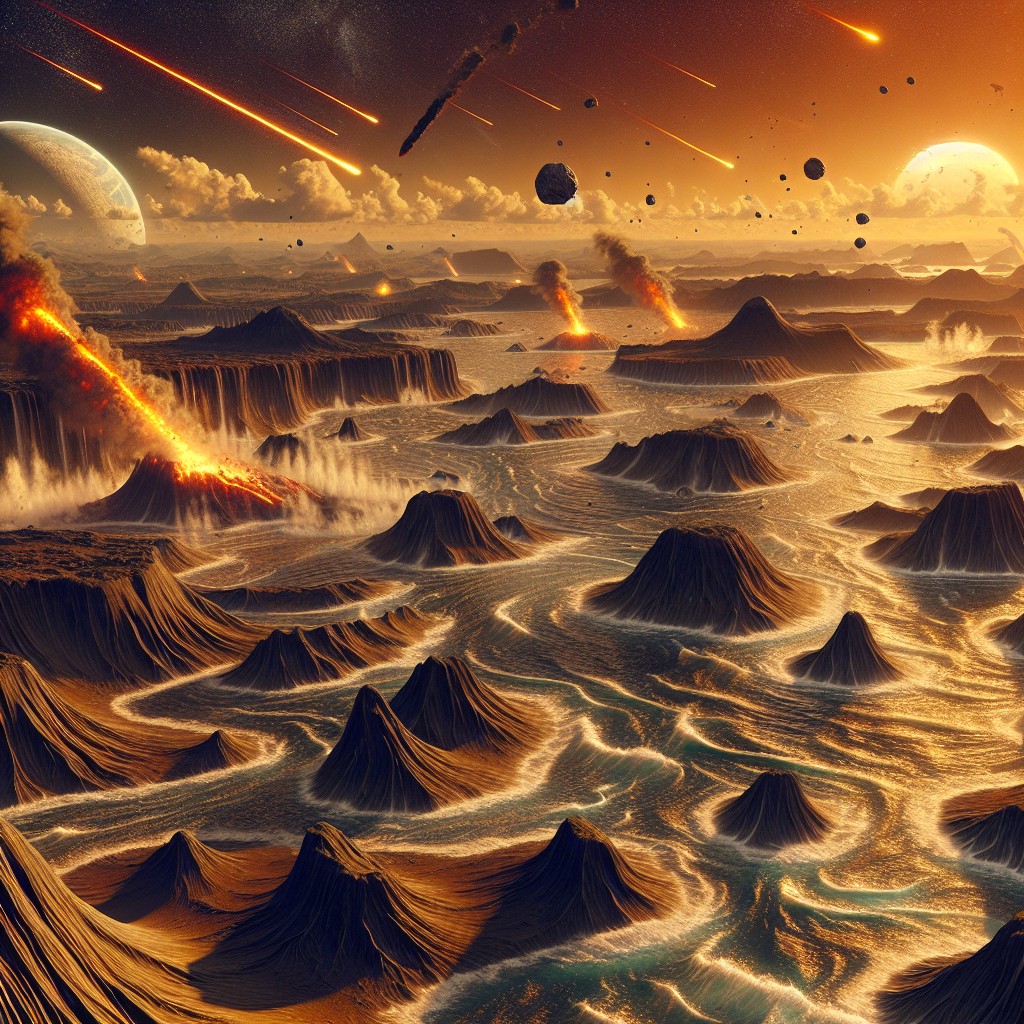The Archean Eon, spanning from approximately 4.0 to 2.5 billion years ago, represents a pivotal chapter in Earth’s geological history. This era is characterised by the formation of the planet’s first stable crust and the emergence of life, albeit in its most primitive forms. The term “Archean” is derived from the Greek word “archaios,” meaning ancient, which aptly reflects the eon’s significance in the context of Earth’s development.
The Archean Eon is often viewed as a time of transformation, where the planet transitioned from a molten state to one that could support life, setting the stage for the complex biosphere that would follow. During this eon, the Earth was a vastly different place compared to today. The atmosphere was likely rich in methane and ammonia, with little to no free oxygen present.
The oceans were also in their infancy, filled with dissolved minerals and organic compounds. The geological processes that shaped the planet were dominated by volcanic activity and tectonic movements, leading to the formation of the first continental landmasses. Understanding the Archean Eon is crucial for comprehending not only the origins of life but also the early environmental conditions that influenced biological evolution.
Summary
- The Archean Eon, lasting from 4 to 2.5 billion years ago, was a crucial period in Earth’s history.
- Geological and environmental conditions during the Archean Eon were characterized by high temperatures, volcanic activity, and the absence of free oxygen in the atmosphere.
- The emergence of the first life forms, such as single-celled organisms, marked a significant milestone in the Archean Eon.
- Early continents began to form during the Archean Eon, shaping the Earth’s landmasses and contributing to the planet’s geological evolution.
- Evidence of early life in the Archean Eon includes fossilized microorganisms and stromatolites, providing valuable insights into the planet’s early biological history.
Geological and Environmental Conditions during the Archean Eon
The geological landscape of the Archean Eon was marked by intense volcanic activity and the formation of the first continental crust. The Earth’s surface was predominantly composed of basaltic rocks, which were formed from the cooling of molten lava. As tectonic processes began to operate, these basaltic formations gradually evolved into more complex structures, including granite and other igneous rocks.
The formation of cratons—stable portions of the continental crust—was a significant development during this period. These cratons served as the foundation for future continental masses and played a crucial role in shaping Earth’s geology. The environmental conditions during the Archean Eon were harsh and inhospitable by modern standards.
The atmosphere lacked oxygen, creating a reducing environment that was conducive to the formation of organic molecules. High levels of volcanic gases contributed to the greenhouse effect, resulting in elevated surface temperatures. The oceans, which were likely shallow and warm, provided a unique habitat for early life forms.
This combination of geological activity and environmental conditions set the stage for the emergence of life.
Emergence of the First Life Forms
The emergence of life during the Archean Eon is one of the most significant milestones in Earth’s history. While definitive evidence remains elusive, scientists believe that life began in the form of simple prokaryotic organisms, such as bacteria and archaea. These microorganisms were likely anaerobic, thriving in environments devoid of oxygen.
The earliest life forms are thought to have arisen from simple organic compounds through processes such as abiogenesis or panspermia, where life may have been delivered to Earth via comets or meteorites. One of the most compelling hypotheses regarding the origin of life is the “RNA world” hypothesis, which posits that ribonucleic acid (RNA) molecules played a crucial role in early biological processes. RNA has the unique ability to store genetic information and catalyse chemical reactions, suggesting that it could have been a precursor to DNA-based life forms.
The discovery of ribozymes—RNA molecules capable of catalysing their own replication—provides support for this theory. The emergence of these primitive life forms marked a turning point in Earth’s history, as they began to interact with their environment and influence geological processes.
Early Continents Formation
The formation of early continents during the Archean Eon was a complex process driven by tectonic activity and volcanic eruptions. Initially, the Earth’s crust was thin and unstable, with frequent volcanic activity contributing to its growth. Over time, as cooling occurred and tectonic processes became more pronounced, stable landmasses began to emerge.
These early continents were primarily composed of granitic rocks, which are less dense than their basaltic counterparts and thus able to rise above sea level. The process of continental formation involved several mechanisms, including subduction and accretion. Subduction occurs when one tectonic plate moves under another, leading to melting and recycling of crustal material.
Accretion involves the gradual accumulation of material onto existing landmasses through volcanic activity or sediment deposition. As these processes unfolded, larger landmasses began to coalesce, paving the way for more extensive continental formations in subsequent geological periods. The emergence of these early continents not only altered Earth’s topography but also created new ecological niches for evolving life forms.
Evidence of Early Life in the Archean Eon
Evidence for early life during the Archean Eon primarily comes from fossilised remains and chemical signatures found in ancient rocks. Stromatolites, layered structures formed by microbial mats, are among the most significant indicators of early life. These formations are created by cyanobacteria, which trap sediment and precipitate calcium carbonate, resulting in distinctive layered patterns.
Fossilised stromatolites have been discovered in various locations around the world, including Australia and South Africa, dating back to approximately 3.5 billion years ago. In addition to physical fossils, geochemical evidence also points to early biological activity. Isotopic ratios of carbon found in ancient rocks suggest that biological processes were at play during this time.
For instance, a higher ratio of carbon-12 to carbon-13 can indicate biological activity since living organisms preferentially utilise carbon-12 during photosynthesis or other metabolic processes. Such isotopic signatures provide compelling evidence that life existed during the Archean Eon and played a role in shaping Earth’s early environment.
Impact of Early Life on the Environment
Atmospheric Composition and the Great Oxidation Event
The emergence of early life forms had profound implications for the Earth’s environment during the Archean Eon. One of the most significant impacts was on atmospheric composition. As photosynthetic organisms, such as cyanobacteria, began to proliferate, they produced oxygen as a by-product of photosynthesis. This process gradually increased atmospheric oxygen levels, leading to what is known as the Great Oxidation Event—a critical turning point in the Earth’s history that would eventually allow for more complex life forms to evolve.
Biogeochemical Cycles and Nutrient Availability
Early life contributed to biogeochemical cycles that regulated nutrient availability and energy flow within ecosystems. Microbial communities played essential roles in nutrient cycling, breaking down organic matter and facilitating the recycling of elements such as nitrogen and phosphorus.
Foundations of Biological Diversity and Ecological Dynamics
These processes not only supported microbial life but also laid the groundwork for more complex food webs that would develop in later geological periods.
Evolution of Early Continents
As time progressed through the Archean Eon, early continents underwent significant changes driven by tectonic activity and climatic shifts. The gradual accumulation of sediments from erosion contributed to continental growth while also influencing geological features such as mountain ranges and basins. The interplay between tectonics and sedimentation created diverse landscapes that would become crucial habitats for evolving life forms.
The evolution of early continents also involved changes in their configuration over time. Continental drift—a process driven by plate tectonics—resulted in shifting landmasses that altered oceanic currents and climate patterns. This dynamic environment fostered biodiversity by creating isolated habitats where species could evolve independently.
As continents continued to grow and shift, they provided new opportunities for life to adapt and diversify, setting the stage for future evolutionary developments.
Legacy of the Archean Eon
The legacy of the Archean Eon is profound and far-reaching, laying the groundwork for subsequent geological epochs and biological evolution. The formation of stable continental crusts provided a platform for future landmasses to develop, while the emergence of early life initiated complex biogeochemical cycles that would shape Earth’s ecosystems for billions of years to come. The gradual increase in atmospheric oxygen set off a chain reaction that ultimately led to more complex multicellular organisms.
Furthermore, understanding this eon offers insights into planetary evolution beyond Earth. The conditions that fostered early life on our planet may provide clues about potential life on other celestial bodies within our solar system or beyond. By studying ancient rocks and fossils from this era, scientists can glean information about life’s resilience and adaptability in extreme environments—knowledge that could inform future astrobiological explorations.
In summary, the Archean Eon stands as a testament to Earth’s dynamic history—a time when geological processes intertwined with biological evolution to create a foundation upon which all subsequent life would build. Its study not only enriches our understanding of our planet’s past but also inspires curiosity about life’s potential elsewhere in the universe.
FAQs
What is the Archean Eon?
The Archean Eon is a geological eon that lasted from 4.0 to 2.5 billion years ago. It is the second eon of Earth’s history, following the Hadean Eon and preceding the Proterozoic Eon.
What significant events occurred during the Archean Eon?
During the Archean Eon, the first life forms appeared on Earth, primarily in the form of single-celled organisms. Additionally, early continents began to form through the process of plate tectonics.
How did the first life forms appear during the Archean Eon?
The exact process by which the first life forms appeared during the Archean Eon is still a topic of scientific debate. However, it is believed that simple single-celled organisms, such as bacteria and archaea, emerged in the Earth’s oceans.
What role did plate tectonics play during the Archean Eon?
During the Archean Eon, the Earth’s crust was undergoing significant changes due to the movement of tectonic plates. This process led to the formation of early continents and the shaping of the Earth’s surface.
What evidence do we have of the events that occurred during the Archean Eon?
Evidence of the Archean Eon comes from the study of ancient rocks, minerals, and fossils. Scientists also use isotopic dating methods to determine the age of rocks and minerals from this time period.





